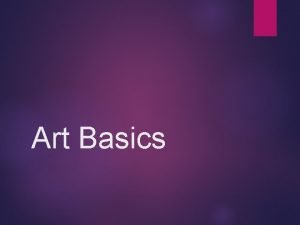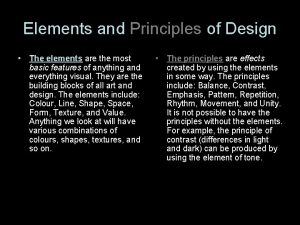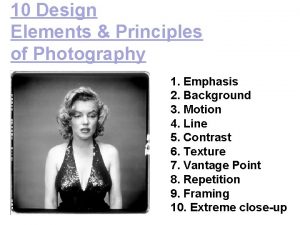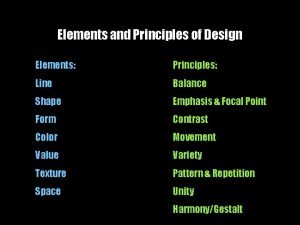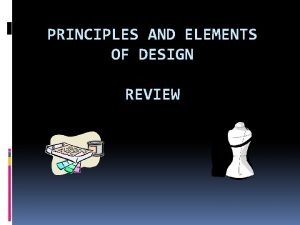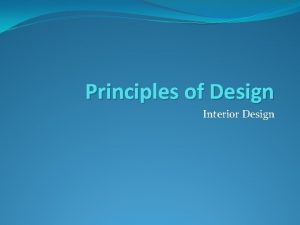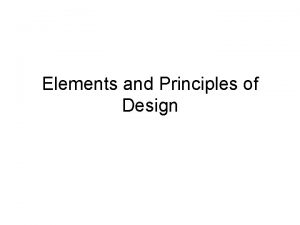Elements and Principles of Design ELEMENTS OF DESIGN










- Slides: 10

Elements and Principles of Design

ELEMENTS OF DESIGN a. Line b. Texture c. Colour d. Form e. Pattern f. Direction (Motion) g. Size h. Point i. Value (Colour) j. Shape k. Depth l. Space (Positive and Negative)

Line: Line can be considered in two ways. The linear marks made with a pen or brush or the edge created when two shapes meet. Texture: Texture is the surface quality of a shape - rough, smooth, soft hard glossy etc. Texture can be physical (tactile) or visual Colour: refers to specific hues and has 3 properties, Chroma, Intensity and Value Texture: Line: Rough Organic Colour:

Form: is the illusion of a 3 -D effect that can be implied with the use of light and shading techniques Pattern: is the repetition of shape or form Direction (Motion): is a visual flow through the composition. It can be the suggestion of motion in a design as you move from object to object by way of placement and position. Pattern:

Size: Size is simply the relationship of the area occupied by one shape to that of another Point: is a single mark in space with a precise, but limited, location. Shape: is a 2 -dimensional line with no form or thickness. Shapes are flat and can be grouped into two categories, geometric and organic. Size: Point:

Depth: Space(Positive and Negative):

PRINCIPLES OF DESIGN a. Balance f. Contrast b. Emphasis g. Harmony c. Proportion (Scale) h. Rhythm d. Repetition (Rhythm/Pattern) i. Dominance e. Unity

Balance: Balance is an equilibrium that results from looking at images and judging them against our ideas of physical structure. Emphasis: The focal point of an image, or when one area or thing stand out the most. Proportion(Scale): The comparative relationship of one part to another with respect to size quantity, or degree

Repetition (Rhythm/Pattern): A regular repetition of elements to produce the look and feel of movement Unity: When all the elements and principles work together to make a pleasing image Contrast: A large difference between two things to create interest and tension

Harmony: brings together a composition with similar units. If your composition was using wavy lines and organic shapes you would stay with those types of lines and not put in just one geometric shape. Rhythm: Rhythm is the repetition or alternation of elements, often with defined intervals between them. Rhythm can create a sense of movement, and can establish pattern and texture. There are many different kinds of rhythm, often defined by the feeling it evokes when looking at it. Dominance: Dominance relates to varying degrees of emphasis in design. It determines the visual weight of a composition, establishes space and perspective, and often resolves where the eye goes first when looking at a design.
 Form in hair design
Form in hair design Design elements hair
Design elements hair Radial balance in floral design
Radial balance in floral design Principles and elements of design chart
Principles and elements of design chart Elements and principles of design ppt
Elements and principles of design ppt Visual elements and principles of design matrix
Visual elements and principles of design matrix Line shape form color texture space
Line shape form color texture space Elements and principles of design fashion
Elements and principles of design fashion Design elements and principles of the universe
Design elements and principles of the universe Elements of design photography
Elements of design photography Elements and principles of architecture
Elements and principles of architecture






